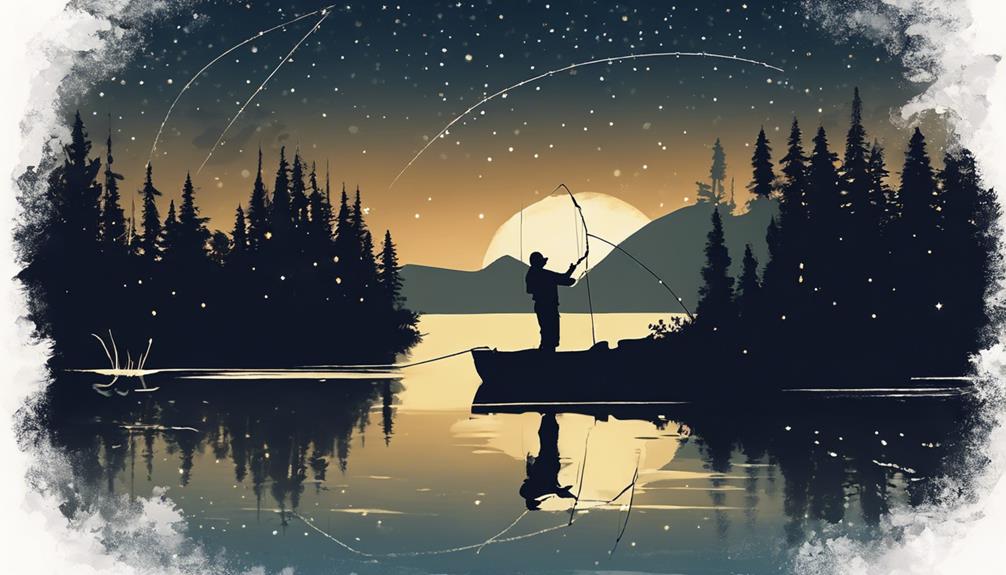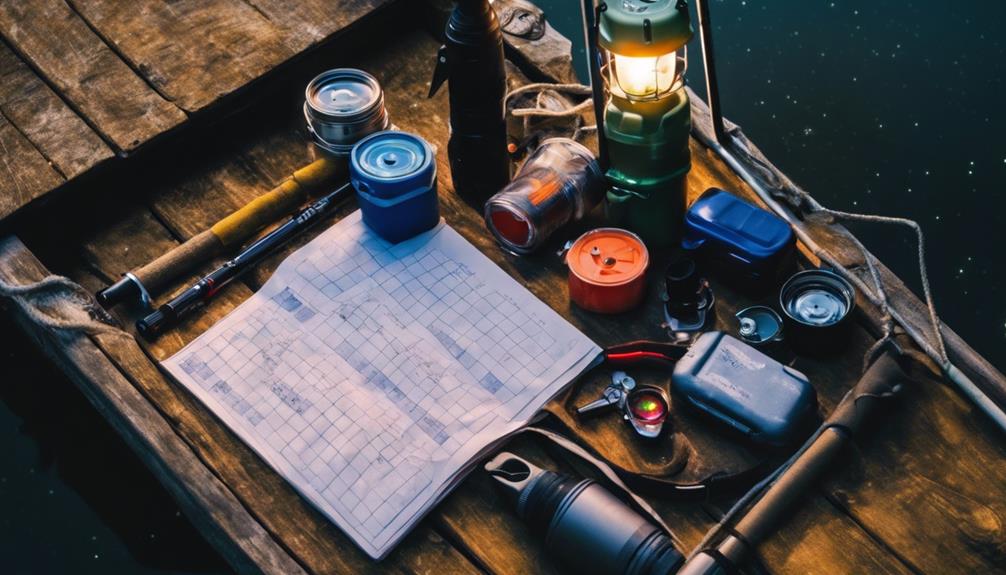Target trout during peak activity near sunset and sunrise for successful night fishing. Adjust fishing times based on water temperature and focus on cooler nights. Ensure gear is in top condition with sensitive rods and reels. Opt for brightly colored or glow-in-the-dark lures for visibility. Use live bait or high-visibility artificial baits optimized for trout's senses. Moon phases affect visibility, consider using headlamps for casting. Locate trout in areas with natural cover and minimized artificial lighting. Prioritize safety with proper gear, reflective clothing, and awareness. With the right strategies, gear, and bait, enhance your night fishing experience and maximize success.
Best Time to Fish for Trout at Night
When targeting trout at night, aim to fish during the hours of highest trout activity, typically within a few hours of sunset and sunrise. This is when trout are most active and feeding.
Moon phases play a crucial role in night-time trout fishing. During a full moon, the increased light can make trout more cautious and less likely to venture into the shallows, so fishing may be more challenging. Conversely, during a new moon, when there's minimal light, trout may feel more confident to forage closer to the shore. Therefore, targeting trout during a new moon phase might increase your chances of success.
Another important factor to consider is water temperature. Trout are cold-blooded creatures, meaning their activity levels are influenced by the temperature of the water. In general, trout are more active in cooler water temperatures. Therefore, during hot summer nights, trout may be less active and feeding during the cooler hours of early morning may yield better results. On the other hand, during cooler nights, trout may be more active throughout the night.
Pay attention to the water temperature and adjust your fishing times accordingly to maximize your chances of a successful catch.
Choosing the Right Gear and Tackle
To effectively target trout during night-time fishing excursions, selecting the appropriate gear and tackle is paramount for increasing your chances of a successful catch. When fishing at night, it's crucial to ensure your gear is in top condition. Regular gear maintenance, such as checking your fishing line for any signs of wear or damage, is essential. Make sure your reels are clean and properly lubricated to prevent any issues that could cost you a catch. Additionally, inspect your rods for any nicks or cracks that could potentially lead to breakage during a crucial moment.
In terms of tackle selection, opt for gear that's suitable for low-light conditions. Choose a fishing rod that's sensitive enough to detect the subtle bites typical of night fishing. Select reels with smooth drag systems to handle the potentially larger trout that come out to feed under the cover of darkness. Consider using brightly colored lures or glow-in-the-dark options to attract the attention of trout in the dark waters.
When it comes to gear maintenance, attention to detail can make all the difference in your night-time trout fishing success. By ensuring your gear is in top shape and selecting the right tackle for night fishing conditions, you set yourself up for a more productive and enjoyable fishing experience.
Selecting the Ideal Bait for Trout
Selecting the ideal bait for trout involves understanding the feeding habits and preferences of these elusive fish species in order to maximize your chances of a successful catch. When fishing for trout at night, it's essential to consider bait options that aren't only effective but also cater to the trout's limited night vision. One of the most popular and effective bait choices for night-time trout fishing is using live bait such as nightcrawlers, minnows, or insects. These options appeal to the trout's natural feeding instincts and are easily detectable in low light conditions due to their movement and scent.
Additionally, artificial baits like soft plastic lures or spinners can be successful alternatives for night-time trout fishing. When selecting artificial baits, opt for those with high visibility in the water, such as brightly colored lures or those with added features like glowing paints or reflective surfaces. These baits enhance visibility for the trout, increasing the chances of attracting a bite in the dark.
Remember that trout rely heavily on their sense of smell and vibration detection in low light environments, so incorporating scented baits or those with rattling components can significantly improve your bait's effectiveness. By choosing baits that cater to the trout's night vision and sensory capabilities, you can optimize your fishing experience and increase your chances of landing a prized catch.
Techniques for Casting in the Dark
Consider utilizing specialized casting techniques tailored for low light conditions when fishing for trout at night. Moon phases play a crucial role in determining visibility during night fishing sessions. When the moon is full, it provides significant illumination, making casting more manageable. However, during a new moon, visibility decreases, and anglers may encounter challenges when trying to cast accurately.
Artificial lighting can aid in casting during dark hours. Using headlamps or small lights attached to your fishing gear can help you see better and improve your casting precision. Be cautious not to shine the light directly into the water, as it may startle the trout. Shadows cast by trees or structures near the water can also affect your visibility. Position yourself in a way that minimizes the impact of these shadows on your casting accuracy.
To cast effectively in the dark, focus on your casting mechanics. Practice your casting during daylight hours to build muscle memory, which will help you when visibility is reduced. Use the sound of the line or the feel of the rod to gauge the distance and accuracy of your cast. By honing your skills and adapting to low light conditions, you can enhance your night-time trout fishing experience.
Locating Trout in the Night
When fishing for trout at night, focus on identifying key environmental factors that attract these fish to specific locations. Moon phases play a crucial role in trout behavior during the night. Full moon phases can enhance visibility for both the angler and the trout, making it easier to locate the fish. Trout are more active during nights with brighter moons, as they feel safer to feed under the cover of the moonlight. On the other hand, during new moon phases when the night is darker, trout may be more cautious and stick to deeper, sheltered areas.
Another important factor to consider when locating trout in the night is light pollution. Light pollution from nearby cities or artificial sources can impact trout behavior. Trout are naturally sensitive to light, so excessive artificial lighting can deter them from venturing into shallower waters or feeding areas. Look for spots away from bright lights or urban areas for better chances of finding trout actively feeding at night.
Areas with natural cover such as overhanging trees or rocks can provide trout with a sense of security, making them more likely to be present in these locations during the night. Paying attention to moon phases and avoiding light pollution can significantly improve your success in locating trout during night fishing expeditions.
Safety Precautions for Night Fishing
To ensure your safety during night fishing expeditions, prioritize proper equipment and preparation to mitigate potential risks.
Night fishing visibility is crucial for your safety. Equip yourself with a reliable headlamp or flashlight with extra batteries to maintain visibility in low-light conditions. Consider using a headlamp as it allows for hands-free operation, enabling you to handle fishing gear and move around safely. Additionally, wearing reflective clothing or gear can help others spot you easily, especially if you're near water bodies or in areas with low visibility.
When it comes to night fishing equipment, several essentials can enhance your safety. A fully-charged cell phone or two-way radio can be vital in case of emergencies. Make sure someone knows your location and expected return time. Carrying a first aid kit is also essential for addressing any minor injuries promptly.
Moreover, being aware of your surroundings is key to staying safe while night fishing. Familiarize yourself with the area during daylight hours, noting any potential hazards or obstacles. Stay vigilant and watch your step, especially near water bodies or uneven terrain. Remember that sound travels differently at night, so be cautious of your surroundings and any wildlife that may be active during nighttime.
Tips for Maximizing Your Night Fishing Success

For optimal success in night fishing, ensure you have the right equipment and strategies in place to enhance your chances of catching trout. When it comes to maximizing your night fishing success, considering moon phases and weather conditions is crucial. Moon phases play a significant role in trout behavior during the night. Full moons can make trout more active and visible, while during new moons, they may be less active and harder to spot. Therefore, planning your night fishing trips around the lunar cycle can greatly improve your chances of success.
Moreover, paying attention to weather conditions is equally important. Trout are sensitive to changes in weather, particularly to sudden drops or rises in temperature. Fishing during stable weather patterns is generally more productive than during turbulent weather. Additionally, overcast nights are ideal for night fishing as they provide low light conditions that make it easier for trout to feed without feeling exposed.
Cleaning and Storing Trout After Night Fishing
After night fishing for trout, promptly clean and store your catch to maintain its freshness and quality. Proper handling and chilling are crucial steps in preserving the flavor and texture of your trout. When cleaning the fish, make sure to remove the entrails and gills thoroughly. Rinse the trout under cold water to remove any blood or debris. Pat the fish dry with paper towels before storing it in the refrigerator.
To ensure optimal freshness for a longer period, consider freezing your trout. When freezing, it's essential to package the fish properly to prevent freezer burn and maintain its taste. You can use a vacuum sealer or heavy-duty freezer bags to wrap individual trout or portions. Make sure to remove all excess air from the packaging to reduce the risk of ice crystals forming on the fish.
When storing trout in the freezer, place the packaged fish in the coldest part of the freezer to maintain a consistent temperature. Properly frozen trout can last for several months without compromising its quality. By following these steps for cleaning and storing your trout after night fishing, you can enjoy delicious meals with your fresh catch at any time.
Frequently Asked Questions
How Can I Differentiate Between Trout Species at Night?
To differentiate between trout species at night, utilize your night vision and observe their behavior. Pay attention to their nocturnal habits like feeding patterns and movement.
Look for specific characteristics such as coloration, fin shape, and markings. Use a light source to enhance visibility but be mindful not to startle the fish.
Are There Any Specific Moon Phases That Affect Trout Behavior?
Specific lunar phases can impact trout behavior significantly during night fishing. The moon's brightness, which varies with its phases, affects the visibility of prey and predators for trout.
For instance, during a full moon, trout may be more cautious and less active due to increased light levels, making them harder to catch.
Understanding how lunar phases influence night vision and trout behavior can help optimize fishing strategies for better success.
What Are the Best Ways to Prevent Line Tangles in the Dark?
To prevent line tangles in the dark while night-time trout fishing, utilize the flashlight technique to illuminate your line and avoid snags. Attach line glowsticks for enhanced visibility.
Wear reflective gear to easily spot your equipment. Utilize rod holders to keep your rods organized and prevent entanglements.
These strategies will assist you in maintaining a tangle-free fishing experience during nighttime outings.
Can Artificial Lures Be as Effective as Live Bait for Night Fishing?
When night fishing for trout, artificial lures can be just as effective as live bait if chosen and presented correctly. Lure selection plays a significant role in enticing trout in low-light conditions. Opt for lures that create vibrations or have bright colors to attract fish.
Focus on bait presentation by using slow, erratic movements to mimic live prey. Experiment with different types of artificial lures to find what works best in your fishing environment.
Is It Necessary to Use a Specialized Net for Landing Trout at Night?
When landing trout at night, using a specialized net isn't always necessary, but it can be beneficial. A fishing net designed for trout can help safely secure the fish during the landing process, especially in low-light conditions.
Additionally, having the right fishing gear, such as a durable net with proper mesh size, can aid in efficiently handling the catch. Consider using appropriate lighting options to enhance visibility and ensure a successful trout landing experience.
Conclusion
In conclusion, night-time trout fishing requires careful planning, the right gear, and a solid understanding of trout behavior.
By choosing the best time to fish, selecting the right bait, mastering casting techniques, and staying safe on the water, you can maximize your success.
Remember to clean and store your trout properly after night fishing to ensure the quality of your catch.
With practice and dedication, night-time trout fishing can be a rewarding and enjoyable experience for any angler.



